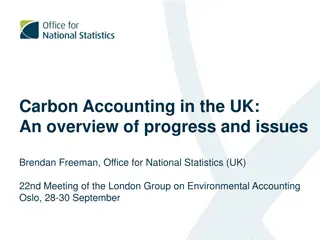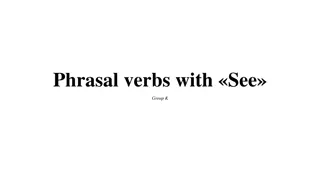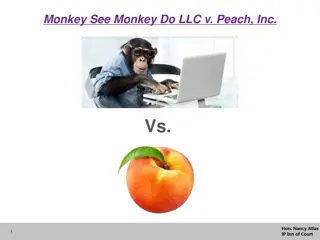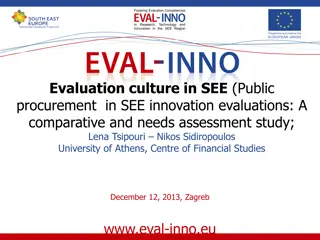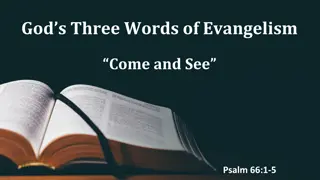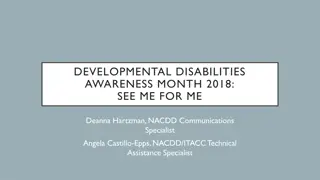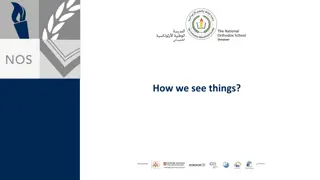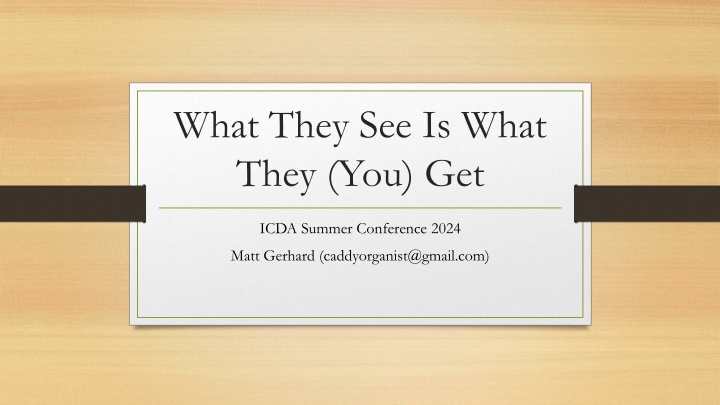
Exploring Non-Verbal Communication in Choirs with Rodney Eichenberger
Dive into the world of non-verbal communication in choirs with Rodney Eichenberger and Gary Bonner. Understand the importance, techniques, and advantages of using gestures over words in choral settings. Learn how non-verbal cues can enhance choir dynamics and engagement.
Download Presentation

Please find below an Image/Link to download the presentation.
The content on the website is provided AS IS for your information and personal use only. It may not be sold, licensed, or shared on other websites without obtaining consent from the author. If you encounter any issues during the download, it is possible that the publisher has removed the file from their server.
You are allowed to download the files provided on this website for personal or commercial use, subject to the condition that they are used lawfully. All files are the property of their respective owners.
The content on the website is provided AS IS for your information and personal use only. It may not be sold, licensed, or shared on other websites without obtaining consent from the author.
E N D
Presentation Transcript
What They See Is What They (You) Get ICDA Summer Conference 2024 Matt Gerhard (caddyorganist@gmail.com)
Non-Verbal Communication in the Choir Exploring the techniques and philosophies of Rodney Eichenberger and Gary Bonner Why non-verbal communication is important Specific techniques to use
Why non-verbal? More can be communicated through a gesture than through words even if the gesture may not be as exact or as logical as a clearly spoken directive. If singers are actively searching for what the conductor is trying to communicate, using gestures increases the mental activity and puts some ownership on the singers, increasing their own gratification. Individual singers can internalize for themselves how the gesture is working on their voices when applied to singing. Words are often too confining to express desired singing affects
Why non-verbal? The ambiguous nature of a gesture can be an advantage. Verbalization can hamper those singers who are already doing what the conductor wants them to do. Because of the diversity of individuals in a choir, there is great difficulty in using words to address issues that may apply to only some of the group. Verbal instructions can make problems for those that didn t have them before.
Why non-verbal? Verbal instructions can take too much time, and people don t listen when you talk. If the singers are active and moving with you, they re more likely to be engaged. The more you talk and the more you explain, the more your people zone out. Gary Bonner
Formation of their philosophies Born out of feedback/criticism from trusted leaders in the choral field. Not being satisfied with the sound of their ensembles. Observation of the sound of the choir changing based on who was conducting.
Rodney Eichenberger Born in 1930 Began singing as a child lead by his mother at the piano Joined choir as a junior in high school Graduated from St. Olaf College in 1952 Sang under Olaf Christiansen Taught junior and senior high school
Rodney Eichenberger 1958 earned a Master of Arts degree from the University of Denver Did graduate work at the University of Washington and the University of Iowa (with Daniel Moe) Became quite prolific as a conductor, adjudicator, and choral clinician Granted tenure at the University of Washington, The University of Southern California, and The Florida State University Published two videos: What They See is What Yet Get (1994), and Enhancing Musicality Through Movement (2001)
Rodney Eichenberger University of Washington Period of discovery began here while studying voice and teaching undergraduate choral conducting. Relationship between his voice study and choral study was close. Voice teacher Edison Harris used body movement to teach certain things about the voice. Became convinced that a conductor s movements and non-verbal messages directly affect the response of a choir.
Rodney Eichenberger University of Washington Theodore Norman, chair of the Music Education Department I think that the sopranos wouldn t be quite so strident if you didn t have so much tension in your shoulders. When he relaxed his shoulders, he could get a much better sound. Had been reaching toward the singers to place his gestures in line with the singers eyes as he learned at St. Olaf.
Rodney Eichenberger Observed among the students in the doctoral program at the UofW that each conductor had their own style locked into his or her muscle memory. I discovered that the sound of the choir changed with each conductor. Once again my approach to teaching changed. Cueing and prescribing procedures were not my primary focuses. Instead, I investigated the personal qualities a conductor uses to make music and how those qualities affect the performance. I began to mentally catalogue things that conductors do that get in the way of their intent. As I started to isolate those things, I would watch a conductor and ask myself, What is the most alterable trait that will make this conductor more effective?
Rodney Eichenberger Through frequent conducting performances with various choirs he began to experiment with gesture and how it affected choral sound. Because each event was unique with singers of various skill and maturity levels, he had the chance to experiment often and see what techniques worked with consistent effectiveness. He began to systemize his concepts and ideas.
Rodney Eichenberger Studies and Literature Triune Brain Theory of Paul D. Maclean, Dalcrose Method, Alexander Technique, Rudolf Laban, Hand and Mind by David McNeill. All levels of the brain need to be stimulated effectively to produce positive musical results. The more one is drawn into the visual aspects of another person s movement, the more one will imitate that action. Hence, only an engaged mind has any chance of being affected by a conductor s gestures.
Rodney Eichenberger Changed his entire approach to warm-ups and began to incorporate physical activity into rehearsals. Increased energy as well as mental stimulation. Solidified the singer s understanding of the meaning of the conductor s gestures. Do this or Try it like this and then asked the singers to talk about the effect. By establishing a connection between the prescribed motions and the desired sound, the singers could more effectively respond when they saw that same gesture coming from a conductor.
Rodney Eichenberger Conductor-Singer Gestures If the singers are active and move with him, they are more engaged. In rehearsal he has the singers imitate the specified gesture so that a connection is made between the desired effect and the gesture. Walking or swaying to internalize a rhythm Simple hand motion for expressing a nuance In performance when they see the gesture they remember what they did in rehearsal and sing the desired effect.
Rodney Eichenberger Deviates from traditional conducting whenever he feels there is a need to do so. the pattern is wonderful and deserves to be learned and used but if something can be made more beautiful by ignoring the pattern, I ll leave it fast. A smoothly conducted pattern doesn t convey as much line and connectedness as a slow, sustained motion in one direction. Raise hand slowly upward The gradual and steady motion has a linear effect as opposed to the jerkier pattern.
Rodney Eichenberger Most gestures created in rehearsal out of necessity Lack of energy Both hands move in a circular motion, inward and upward through the pelvic region to draw attention to lower breathing and connect it with singing. When the choir imitates the motion, it increases energy and gives a sense of direction and propulsion to the singing. Once the singers notice the difference, presumably they can duplicate the desired singing again in performance without doing the circles themselves. The conductor can perform the gesture to reinforce the singer s consciousness and memory
Rodney Eichenberger Brighten tone and raise soft palate Cupped Ear The hand is cupped forward, next to the ear, as if holding a tennis ball, and, as it slowly curved upward, forward, and above the ear, the soft palate should lift as well. He will have the singers sing while they lower the hand and the raise it again, as they raise it again, he will comment, That s the one I like better.
Rodney Eichenberger Tone too far back Have the choir hum a note and tell them to point their index finger up and forward. This immediately brings the tone forward to the desired pointed nn sound. Jaws of the singers are too tight and need to be relaxed Make a movement on the side of your face, perhaps with the back of your fingers moving downward along the cheek to indicate the desired jaw position.
General thoughts - Eichenberger It is important to be conscious always of what is being affected by a given motion and what subsequent motion should follow. It is important to consider that sometimes a given motion doesn t work exactly as it had been intended, or it has a different, adverse effect. We must be aware of circumstances and be willing to adapt using whatever means necessary, even if it means creating a new gesture to achieve the desired affect.
Gary Bonner Born 1937 Began playing trumpet in elementary school and continued through high school Joined choir as a junior in high school (singing under Sheldon Disrud) Student conductor of both groups
Gary Bonner Bachelor of Arts degree from Pasadena College (now Point Loma Nazarene University) in 1959 Master of Arts degree from California State University at Los Angeles Ed.D. from University of Southern California Studied in a week-long seminars with Dr. Howard Swann, Norman Luboff, and Frak Pooler
Gary Bonner Built a large high school program at Azusa High School 1971 invited to join the faculty at Azusa Pacific College (now University) and to give leadership to the music program Founded the Male Chorale and the University Choir and Orchestra Numerous recordings, concert tours, TV specials, and performances with major symphonies, and the Gary Bonner Choral Series with Tempo Music
Gary Bonner 1993 left APU and formed The Bonner Institute for the Advancement of Choral Music Formed the semi-professional Gary Bonner Singers (now The Bonner Singers) Performed at the White House three times Produced over 20 recordings Four albums of commissioned pieces The Gary Bonner Choral Series with PraiseGathering and later Hal Leonard
Gary Bonner 2002 founding dean of the School of Music at California Baptist University Created the 130-member University Choir and Orchestra Recorded numerous albums and two DVDs Numerous tours and performances across the country Currently retired
Gary Bonner While teaching high school received a D from Howard Swann at a choral festival who said the tone was strident. Realized the success of his programs was based on the charisma and energy emanating from the performers. While recording the APU Male Chorale and fighting pitch problems, was told by a producer I think that s as good as you can get it. Decided that pointing the fingers, or lifting the eyebrows, or telling the singers to lift their pitch didn t work.
Gary Bonner After fighting pitch problems in recording session Had the singers spread their feet, slightly pigeon their toes, and bend their knees, moving into an athletic, ready position. He began lifting his hand above his head, and with his thumb and index or middle finger tug an imaginary string upward to lift the pitch, all the while presenting his eyes, face, and body with the energetic command to brighten the tone and lift the pitch.
Gary Bonner Began to open his hands and fingers to produce a sense of space as he manipulated the pattern into a propulsion of air and energy. Enabled him to move his fingers independently to create some sparkle or spin in the tone. The obvious effect of these changes encouraged Bonner to go further in experimentation, questioning everything he had been taught regarding conventional conducting approaches.
Gary Bonner Crescendo Couldn t achieve the yearning he wanted while doing a crescendo on the word deep using traditional method. Was not enough tension to create the pull of the necessary crescendo nor the support needed for the decrescendo on the descending eighth notes. Finally acted as though his left hand was holding something malleable, 5 inches or so in diameter, then grabbed it from above and stretched it about 18 inches long for the crescendo before pushing it back for the decrescendo.
Gary Bonner Crescendo continued His entire physical presence communicated that he was using a great deal of strength to perform the motion, like he was pulling and pushing taffy, using isometric tension throughout the body and face. Discovered this taffy pull worked effectively to achieve and energized, yet controlled, crescendo and diminuendo. Lead to the realization that he could control the sound without communicating verbally if he could find the right physiological tools. Some gestures were the result of quiet reflection, others were discovered on the spot.
Gary Bonner Reflecting on a request from a producer while recording Exaltation: I don t think they could do it without somebody demonstrating what that picture was. And I think that s really important in this journey because I think that made it all just explode in my mind that, Oh! Any picture we want, we can do it if we do it right, and if we can get everybody to submit, and that word [submit] becomes huge in this concept of conducting. So submission is maybe even more important than musicality. But then again it puts responsibility back on you, the conductor, so you say, okay, I want it to sound like this. But you don t have time in a performance, or you don t even have time in most rehearsals to tell them what you re doing, so gradually what you want to do is to have a language that they can understand or even want to understand so that every motion has a value. If it has no value throw it away quick.
Gary Bonner This epiphany resulted in Bonner risking more to discover how much effect he could have on his choirs without verbalizing unless it was absolutely necessary. Following the success of Exaltation he began to receive inquiries on how he achieved his sound which lead to conducting seminars which lead to his techniques taking on a more definitive quality. Heart of his philosophy: a great conductor needs to exhibit space, energy, freedom, and motion.
Gary Bonner Conducting stance Legs planted shoulder width apart, arms held from the shoulder to the elbow at roughly a 45-degree angle creating space in the chest with the chest held high, forearms and hands angle forward as if preparing to hug the ensemble, fingers spread as if holding a large grapefruit, eyes bright and alive with raised eyebrows, mouth often open (depending on the vowel shaping desired). If the sound needs to get bigger, the stance expands If the sound needs to get softer, the space contracts Rarely does it close, or push the choir away with the palms facing the group Even in the softest pp, the conductor should still be holding the choir and the sound with openness, roundness, and support.
Gary Bonner Mouth Space is necessary for vowel shaping. Will often tell a new choir my mouth to instruct them to shape their vowels like him If all are working to shape their vowels with the conductor, the pronunciation becomes unified with a better blend. Increases mental activity and a sense of personal responsibility. Work against any negative tendencies
Gary Bonner The conductor is the catalyst for the choir s energy No choir will sing well if the conductor lacks energy. Necessary from the moment you walk into the rehearsal to engage the singers. Once they sense your lack of energy, their energy will begin to lag. Energy stems from every physical movement, beginning with the legs and moving right up to the eyes. Eyes are most powerful non-verbal tool we have.
Gary Bonner Every motion should mean something. A tremendous amount of energy must go to movement that will make something happen. Requires mental vitality and physical power If the singers are relying on the conductor to sculpt the music, the conductor cannot simply make the sign for a crescendo, they must physically make it happen. The entire physical presence is lifting the sound.
Gary Bonner It s not enough to give a signal for singing a phrase with a sense of line. The conductor must create line in the music with the whole body, moving the pattern, as if through mud, so that an isometric tension is created, leading any engaged singer to tie the notes together. Singing and dancing belong together. Wilhelm Ehmann Choral Conducting Conductor should exhibit freedom. While positive tension should be employed to create nuanced phrasing, there should always be a sense of freedom and motion while the music is happening.
Gary Bonner The conductor should feel free to deviate from the standard forms whenever the music may be enhanced. A sweep may be a more effective cue for the beginning of a phrase than a sharp ictus which may produce a glottal thrust in the voice. Circles may be more effective than the pattern for producing flowing musical lines or rejuvenating the voice. Squatting at the knees might produce a more energized pianissimo than holding the hand with the palm facing the choir. Having the choir squat will energize them as well as the audience.
Gary Bonner The motion should not be an intrusion upon the music or seem out of place. Some argue any movement in a choral performance is out of place. It could be argued that a motionless choral performance is more contradictory to most music making than moving with the music. Where is the electric socket for possibility, the access to the energy of transformation? It s just there over the bar line We can join it by finding the tempo to lean our bodies to the music; dare to let go of the edges of ourselves. Benjamin Zander, conductor of the Boston Philharmonic Moving gets the blood flowing and alleviates tension in the body.
Gary Bonner Motion naturally accompanies music and every musical phrase promotes its own unique body movement. The conductor should work free themselves and the singers of restrictions that are counter to the natural quality of the music and facilitate motion in the choir that relaxes and engages the singers and the audience as well.
Gary Bonner Carryover One of the first nonverbal tools Bonner employs when working with a new group. Designed to pull the singers through any place where they might have an inclination to take a breath and to force them to sustain their singing. Eliminates the breath without stopping the rehearsal to verbalize which takes time and diminishes the singer s commitment to follow the conductor. Reinforces the concept that the conductor s motion is actually the musical line.
Gary Bonner Carryover If the conductor increases the isometric tension in their motion at a point where they want the singers to carryover, and the singers are hooked up with the conductor, the effect should be that everyone pulls through together, producing a positive tension in the line. The sound becomes more unified because the entire choir is musically and mentally connected with the conductor. The effect is enhanced further if the conductor varies their interpretation.
Gary Bonner Carryover Possesses a naturally propulsive effect, increasing forward motion. This is in direct proportion to how much energy and power the conductor communicates in their carryover. An outward circle is the most common way to achieve a carryover, with a smaller circle preceding a larger circle. The body must be fully energized and communicate right at the point in question to pull that extra little bit through the potential break in the phrase. If one is reluctant to leave the pattern, add elasticity with a high degree of isometric tension to the pattern at the point when the breath must be be avoided.
Gary Bonner Pitch problems We often make motions that do nothing to alleviate the cause of pitch problems, especially flatting: tightness in the voice, lack of sustained energy, incorrect vocal placement, lack of awareness in the singer that the whole note must be energized. Cut the line Like Ehmann, Bonner believes that the circular pigtail cutoff is inexact, but more importantly, a circular cutoff, if the choir is truly following, should produce a decay of sound or pitch.
Gary Bonner Cut the line Rather than the pigtail, cut in the line with the thumb and forefinger coming together to pinch the line of sound. For a loud cut off, the hand makes a quick flip upward, overhead with little to no downward preparation. The motion stays in one consistent direction until the cutoff. If a gradual softening is desired at the end of a phrase, the hand, body, and eyes support the energy while the hand, palm held open, steadily descends to the cutting point.
Gary Bonner Well-supported fortissimo Low support throw which consists of a wind-up with the legs and arms and literally shoves energy from below through the body. Works against the tendency to tighten the throat, gets pressure out of the throat and calls upon the support of the legs and abdominal region. The conductor should also release the jaw and throat as well to promote openness. As the singers adjust their bodies, the focus is taken off the neck and throat.
Gary Bonner Overheard Fly Born out out of the tenor solo in Gounod s Sanctus and Benedictus from the St. Cecelia Mass. Tenor kept cracking the high A on the first syllable of Pleni sunt on beat one. Finally, Bonner threw his hands high above his head with a great deal of energy in his body and bright eyes just prior to the downbeat, letting the downbeat simply occur without a downbeat ictus. The tenor nailed the note.
Gary Bonner Overheard Fly Anytime singers, especially sopranos approach a high note. Must be performed just ahead of the point at which singing commences to give the necessary freedom, energy, and preparation. Lightens the weight of the voice in the larynx and releases the voice into the upper register.
Gary Bonner Finger dangle Provides visual cue for singers to lighten the vocal placement when a soft texture is needed in the upper registers. Dangle the fingers lightly above the forehead to reinforce a coming-over-the-note rather than pushing from below. Releases tension, raises the soft palate, and brings the tone into the mask.
Gary Bonner Finger feathering A soft still ending of a phrase that needs focus while maintaining slightly more spin and vibrance. A gentle, yet quick and slight flickering of the fingers doesn t interrupt the steady motion of the hand and arm, and it increases motion in the voice without allowing the voices to get out of focus. Can be directed at the whole group, of just an individual.












